|
Spring is here and new arrivals of beautiful backyard songbirds are showing up daily. They are looking for clean and safe housing to raise one, two and sometimes three broods of chicks throughout the spring, summer and fall.
Are you getting ready? Best get a move on!
Wrens, Chickadees, titmice, Bluebirds, nuthatches, small woodpeckers, flycatchers and tree swallows are among the many beautiful species of songbirds that will take up residence in your backyard birdhouses this spring. |
Q. What can I do about raccoons, crows, cats, bluejays and squirrels that can get into the house and destroy the occupants?
A. Attach a Bird Guardian on every birdhouse. They are scientifically designed and attach over small wren and chickadee house entrance holes all the way from one to one and a half inch birdhouse openings.
The squares of wood attached to some houses are not deep enough to protect the birds, especially when a second nest is built up closer to the entrance hole. |
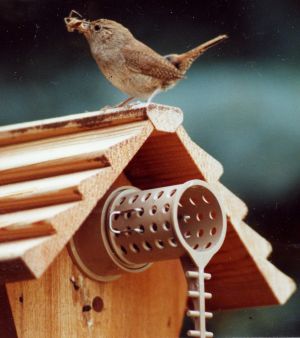 |
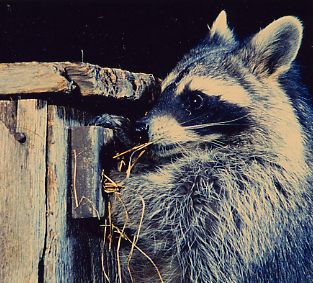 |
Q. I see many birdhouses with perches. Is that a problem?
A. Perches on the front of the nesting box are not necessary since cavity-nesting birds have strong feet that allow them to easily cling to the outside of the box.
The problem with a perch is that it makes the box more accessible to predators and for nuisance birds to land and harass the occupants, sometimes preventing the parent birds from entering and feeding their young. This is an actual photo in which the raccoon pulled out the entire nest. The block of wood attached to the face of the birdhouse is not an adequate deterrent to predators! |
Q. What is important in regard to attracting birds to my backyard?
A. Water is one of the best attractants of all. If you have a spray or running water that is even better. |
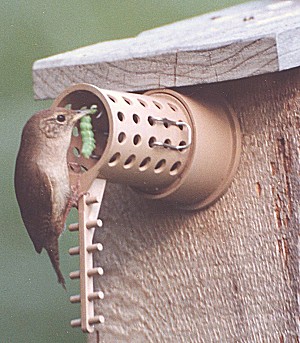 |
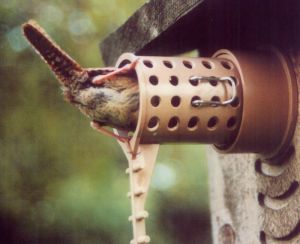 |
Q.When is the best time to clean out your birdhouses?
A. The time is now. Remove old nests and if you feel like painting, be sure to paint only the outside...never the inside! No lead paint. Easy colors, not too dark and not too light. Natural wood with a good stain is always a safe bet.
Make sure your birdhouses have good ventilation and drainage. |
Q. Do I remove the Bird Guardian at the end of the year?
A. No. Keep Bird Guardians on all of your houses year-round. Many species of birds cozy up together in birdhouses in the winter for mutual warmth.
They will be protected from raccoons. |
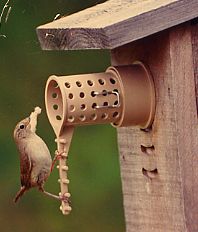
Wren building nest
|
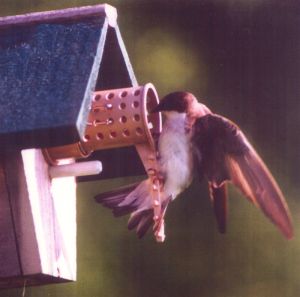
Tree Swallow
|
Q. Is spring and summer feeding necessary or a waste of time?
A. Offering summer food is a treat for humans and birds alike. When folks bring in their feeders at the first sign of spring it can create hardship for the resident and migratory birds alike. Food is scarce during spring and they need our help.
Feeding your backyard birds will encourage them to bring their young to your feeders to get the good stuff and year-round denizens will remember your place. |
Q. Will I get birds in all of my houses if I use Bird Guardians?
A. There is no guarantee you will get birds in every house with or without a Bird Guardian.
Our tests show chickadees, house wrens, tree swallows and other backyard birds actually seem to prefer the Bird Guardian protected boxes leading us to wonder just how smart the little guys are! |
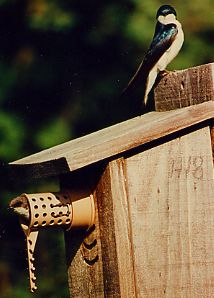
Tree Swallows
|
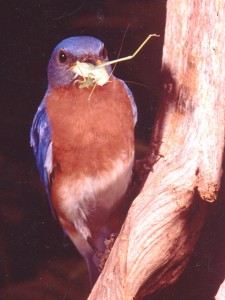
Natural and safe nesting
sites are scarce |
For those individuals who are trying to attract bluebirds we recommend not to apply the guard until after the birds have developed an attachment to the nesting box. This would be after nest building and egg laying, since we found that most of the bluebirds preferred boxes w/o the guards, but accepted them when applied at this time.
We have had bluebirds accept the guards upon inspection of their nest box but not as often as when the guards are applied after nesting begins.
The goal is to protect these birds and sometimes with the bluebird it will take a little more effort to protect them from predators but the extra time is well worth the results of watching a successful fledging of these beautiful young birds! That's the goal...to protect them whether they know it or not. |